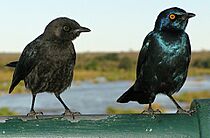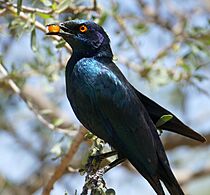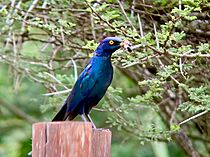Cape starling facts for kids
Quick facts for kids Cape starling |
|
|---|---|
 |
|
| L. n. phoenicopterus in Damaraland, Namibia | |
| Scientific classification | |
| Genus: |
Lamprotornis
|
| Species: |
nitens
|
 |
|
|
L. n. phoenicopterus
L. n. culminator
|
|
| Synonyms | |
|
Turdus nitens Linnaeus, 1766 |
|
The Cape starling (Lamprotornis nitens) is a beautiful, shiny bird found in Southern Africa. It's also known as the red-shouldered glossy-starling or Cape glossy starling. These birds belong to the starling family. You can spot them in woodlands, bushveld areas, and even in suburbs where people live.
Contents
About the Cape Starling
The Cape starling is a medium-sized bird. It has a bright, glossy look. Its feathers shimmer with blue and green colors. This bird is known for its long, musical song. It can even copy sounds it hears around it!
What Does It Look Like?
Adult Cape starlings are about 25 centimeters (10 inches) long. They weigh around 100 grams (3.5 ounces). Their heads are blue, and their bodies are greenish-blue. Young starlings look a bit duller at first. Their eyes change from grey to yellow as they grow. By six months, they look just like the adults.
Where Do They Live?
Cape starlings live in the southern parts of Africa. Their home range includes countries like Angola, Zimbabwe, Namibia, Botswana, Lesotho, and South Africa. They usually stay in one area and do not migrate. These birds like places with trees where they can rest and build nests. You can find them in open forests, parks, gardens, and even in the Kalahari desert where there are scattered trees.
Different Types of Cape Starlings
Scientists recognize two main types, or subspecies, of the Cape starling.
- L. n. phoenicopterus: This type is found widely across Southern Africa.
- L. n. culminator: This type lives mainly in the Eastern Cape of South Africa. It is said to be a bit larger. It also has greener wings and tail feathers.
How They Got Their Name
The scientific name for the Cape starling is Lamprotornis nitens. The word nitens comes from Latin. It means "shining" or "glittering." This name perfectly describes the bird's shiny feathers! A Swedish scientist named Carl Linnaeus first gave it a scientific name in 1766. Later, it was placed in the Lamprotornis group of birds.
Cape Starling Life and Habits
Cape starlings are very social birds. They often gather in large groups when it's not breeding season.
What Do They Eat?
These starlings usually look for food on the ground. They often feed with other types of starlings. Their diet includes fruits, insects, and nectar from flowers. Sometimes, they even eat tiny bugs off the backs of animals! They are used to being around humans. You might even see them visiting bird tables for food scraps.
How They Raise Their Young
Cape starlings usually breed between October and February. They build their nests in small spaces, like holes in trees. They are very good at finding and keeping these nesting spots. Sometimes, a bird called the greater honeyguide will lay its eggs in a Cape starling's nest. This is called brood parasitism, where one bird makes another raise its young. Cape starling parents feed their chicks mostly insects, like grasshoppers and beetles. They also give them fruit and other small creatures.





